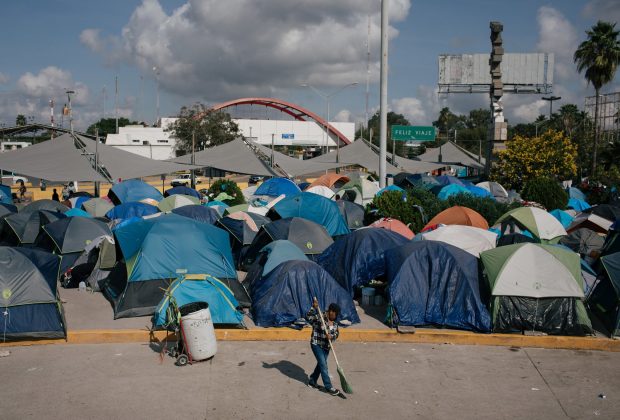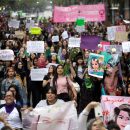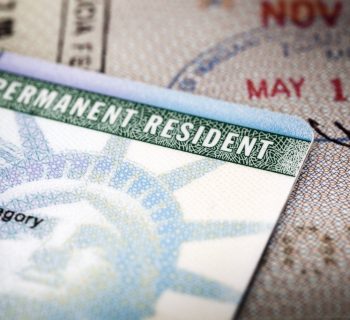The court upheld an injunction blocking a policy that requires asylum applicants to wait in Mexico until their cases are decided. But a stay on the order means the policy could remain in effect.
By: , New York Times –Feb.28, 2020
A federal appeals court found a central pillar of the Trump administration’s immigration agenda legally invalid on Friday, ruling that asylum seekers must be allowed into the United States while their cases weave through American immigration courts.
The court stayed its decision, however, in order to allow the government time to appeal the ruling.
After a year in which nearly a million migrants crossed the southwestern border, jamming processing facilities and defying President Trump’s attempts to curtail immigration, border crossings have dropped sharply in recent months, in part because of the administration’s “Remain in Mexico” policy, the subject of Friday’s court ruling. The decision from the United States Court of Appeals for the Ninth Circuit, if allowed to stand, would eliminate one of the administration’s key levers for controlling the arrival of new asylum seekers.
A three-judge panel in San Francisco upheld an injunction blocking the policy, which has required people applying for asylum at the border to wait in Mexico while their claims for protection are reviewed, a process that often takes months or years.
The judges gave lawyers in the case until Monday to respond to the stay.
Since the “Remain in Mexico” restrictions were rolled out early in 2019, more than 59,000 asylum seekers have been turned back by American authorities into Mexican border cities, where kidnappings and violence have surged. Because shelters in Mexico are scant and overrun, many of the migrants are living in vast tent encampments exposed to the elements. Powerful Mexican drug cartels have moved in to exploit them.
“It’s a resounding rejection,” Judy Rabinovitz of the American Civil Liberties Union, who was the lead lawyer representing the plaintiffs, said of the court’s ruling earlier Friday. She added, “The policy is a disgrace, it’s illegal, it’s morally indefensible, and it needs to stop.”
Chad Wolf, acting secretary of homeland security, said U.S. border officials have continued to process meritorious asylum claims and reduced fraudulent and invalid claims.
“Should this ruling stand, the safety and security of our border communities, international relationships and regional stability is at risk,” he said in a statement.
“This nationwide injunction is grave and reckless, rewrites the laws passed by Congress and undermines the U.S. Constitution,” he said.
Lawyers who brought the challenge represented a group of 11 asylum seekers who had been returned to Mexico and several legal advocacy organizations. The plaintiffs won a nationwide injunction, but because a higher court stayed the ruling, the policy has continued to expand — most recently taking effect in Nogales, Ariz., in December.

These families from Honduras heard rumors that people in the Remain in Mexico Program might be allowed into the United States and went to the bridge to find out.Credit...Cengiz Yar for The New York Times
Friday’s appeals court ruling, before it was stayed, prompted widespread celebration among those who had been fighting the policy, followed by hours of confusion over when and how it might go into effect. Mr. Wolf said his department was working with the Justice Department “to expeditiously appeal this inexplicable decision.” Human rights organizers in the Mexican border cities where asylum seekers are clustered — including Tijuana, Ciudad Juárez and Matamoros — scrambled to analyze the opinion, while also trying to maintain calm among the thousands of migrants now held up in those cities to prevent a panicked rush toward the United States.
Migrants held in Mexico under the policy began gathering at several international bridges. About 50 collected Friday evening at the Paso Del Norte bridge in Ciudad Juárez, hoping to cross into El Paso, but Mexican authorities closed the bridge to all traffic.
A 28-year-old man from Cuba, who was among those trying to cross, said he would wait for an opportunity. “If God wants us to, we will cross,” said the man, who did not want his name published for fear of jeopardizing his asylum case. “I’m going to wait here.”
Late Friday, the Customs and Border Protection agency said it had halted processing of new cases under the program, but that was before the stay. “We are continuing to utilize every tool at C.B.P.’s disposal to ensure the integrity of our immigration system and processing programs,” the agency said in a statement.
The policy at issue is known formally as “migrant protection protocols” — though the lawyers who challenged it argued that it did just the opposite by placing vulnerable people in harm’s way. Instead of safeguarding people fleeing persecution abroad, as is required under federal law, the policy banished them to perilous conditions in a different place, the lawyers said.
Government lawyers defended the policy based on a little-known provision of the 1996 federal immigration law allowing the American government to return some migrants to contiguous countries while their cases for entry into the United States are being processed.
They argued that the provision could be applied to asylum seekers, and that the United States had fulfilled its legal duty to protect people fleeing persecution by conducting a screening to identify possible fears before it sends people back to Mexico.
But those challenging the policy countered that asylum seekers are exempt from the legal provision, and said the government’s provisions for screening to determine whether migrants had a credible fear of persecution was insufficient. They pointed to cases of people who had been kidnapped or raped while they were waiting in Mexico and were told afterward by American authorities that their fear of residing in Mexico was not credible.
In a 2-to-1 opinion on Friday, the appeals court judges said the policy violated the federal government’s obligation to avoid returning migrants to dangerous places, and they concluded that the legal provision invoked by the government in creating the policy was never meant to be applied to asylum seekers.
They found that the policy was “invalid in its entirety” and concluded that a lower-court ruling that initially enjoined its implementation was “not an abuse of discretion.” The stay issued Friday night, the court said, would remain in effect pending review of the government’s petition for an immediate appeal.
Judge William A. Fletcher, an appointee of President Bill Clinton, wrote the opinion, joined by Judge Richard A. Paez, also a Clinton appointee. Judge Ferdinand F. Fernandez, nominated to the court by President George Bush, dissented.
In a separate ruling on Friday, the same panel of appeals court judges rejected another of the Trump administration’s attempts to restrict asylum. In that case, the judges reviewed a policy that blocks anyone who entered the United States illegally — as opposed to presenting themselves at a legal port of entry — from applying for asylum.
The court found unanimously that the policy runs counter to asylum law, which states that people can apply for the status regardless of where they enter the country. That policy had been enjoined by a district court judge shortly after it was announced, and the appeals court on Friday reaffirmed the injunction.
“What’s especially significant is that, in both cases, the court found that the administration ignored Congress,” said Lee Gelernt, deputy director of the American Civil Liberties Union’s Immigrants’ Rights Project, who argued the case.
The administration took additional steps last year to make it harder to apply for asylum, signing a deal with Guatemala to resettle asylum seekers there, instead of in the United States. It also adopted a policy requiring most applicants from Central America to first seek asylum in another country along their route of travel.
That policy is also being challenged in federal court.
The policies are part of a constellation of measures undertaken by the Trump administration to help stem the record number of migrant families, mainly from Central America, who began crossing the border in the fall of 2018.
The influx led to overcrowded detention facilities and overwhelmed immigration courts, prompting President Trump to double down on his pledges to build a wall and clamp down on immigration across the southwestern border.
Taken together, the policies have effectively shrunk the American asylum system to a fraction of what it once was. By the end of the 2019 fiscal year, in October, overall border apprehensions had shrunk to 60,781, from a high of 144,116 in May.
The news that the “Remain in Mexico” policy might be invalidated sparked chaos in some areas of the border, where some migrants have been living for months in filthy and crime-ridden areas, with little hope of entering the United States. Emma Obando, 42, had been cooking plantains for her two sons in the Matamoros tent encampment on Friday when a crying woman ran toward her, yelling to everyone she passed, “We should go; we should cross right now because they have undone the law of M.P.P.”
Ms. Obando has been living in Matamoros with her 7- and 10-year-old sons, the elder of whom has autism, since September, after having fled their home in Honduras. She said many migrants flocked to the border after hearing news of the court ruling on Friday, but soon after, organizers called them off, instead advising people not to “make a big fuss” yet, and to prepare their government documents instead.
Eventually, Ms. Obando said, the mood calmed. She decided to try crossing into the United States with her sons on Saturday.
Mexican officials and civic leaders were also trying to make sense of how the ruling might impact their communities.
“There are various unknowns, various questions,” said Dirvin Luis García Gutiérrez, the head of the migration program for the population agency in the state of Chihuahua.
He said that Ciudad Juárez, where more than 19,700 migrants have been returned under the program, was currently supporting a transient population of between 13,000 and 15,000 migrants, including migrants returned under the program as well as those who are still waiting to cross into the United States to apply for asylum.
In an immigration court in downtown San Diego on Friday morning, more than a dozen migrants who had been subjected to “Remain in Mexico” were in court for their asylum hearings when the appeals court’s opinion was released. Most were not represented by lawyers and had little guidance on how to proceed.
When the “Remain in Mexico” program was initially enjoined by a federal judge in California in April of last year, migrants who had been in court on that day ended up spending more than two weeks in government holding cells while officials decided how to proceed. When the injunction was stayed, the migrants were returned to Mexico, allowed to enter the United States only for their court hearings.
Government officials moved quickly to reverse the decision. It appeared clear that, whatever the immediate outcome, the issue would ultimately be decided by the United States Supreme Court.
Hundreds of asylum seekers who have been returned to Mexico have since given up their claims, accepting free transportation provided by the American government and the United Nations back to their homes in Central America. But others have vowed to continue with their cases.
Yoleydi Gonzalez Jimenez, 26, arrived from Cuba with her husband in the Mexican city of Matamoros in September and has been living in a tent encampment at the end of an international bridge into the United States ever since. With little access to public bathrooms, the camp smells of human waste.
Ms. Gonzalez Jimenez wears socks with her flip-flops to keep warm. A donated air mattress covered with pink and purple sheets fills the tent that has become the couple’s home. Their few possessions are stacked on top and become soaked with water that seeps inside when it rains.
“I can’t give up after all the time I’ve been waiting here, even though I feel like I’m going to die,” she said after a court hearing in December. Her next hearing was scheduled in Brownsville, Texas. Until then, she was told, she would have to go back to Mexico.
Source: New York Times







